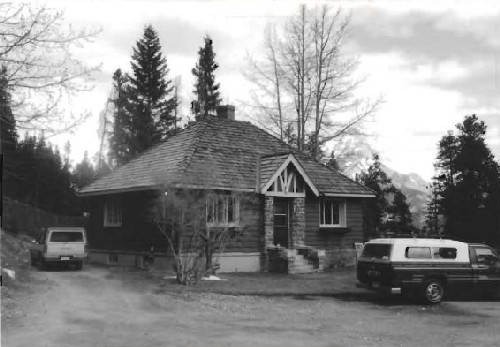Other Name(s)
Cave and Basin Bathing Pavilion
Hot Springs Bathing Pavilion
Pavillon des sources thermales
Links and documents
Construction Date(s)
1912/01/01 to 1914/01/01
Listed on the Canadian Register:
2005/06/16
 Statement of Significance
Statement of Significance
Description of Historic Place
The Cave and Hot Springs Bathing Pavilion in the Banff National Park of Canada consists of a symmetrical frontispiece articulated by two octagonal belvederes. Behind it is a long man-made swimming pool fed by natural hot springs and terminated by a wooden bathhouse structure. Along one side of the swimming pool is a multi-storied and terraced long house containing the change rooms and the interpretive center. Alongside the other side is a simple arcaded stone wall providing enclosure as well as vistas into the landscape. At either end of the long house are the naturalistic Cave and Basin pools. The designation is confined to the footprint of the building.
Heritage Value
The Cave and Hot Springs Bathing Pavilion is a Classified Federal Heritage Building because of its historical associations, and its architectural and environmental values:
Historical value:
The Cave and Hot Springs Bathing Pavilion is one of the best examples of the theme of early Canadian tourism. It is considered the birthplace of Canada’s national parks system and because of the quality of its architectural design. It is also the oldest facility of its type within the Canadian Parks system. The Bathing Pavilion represents the first major undertaking of the National Parks Branch following its establishment in 1911. The discovery of the Cave and Basin Hot Springs and the decision to preserve them from private development provided the catalyst for the establishment of Canada’s first national park and the eventual network of parks.
Architectural value:
The Cave and Hot Springs Bathing Pavilion is a well-crafted and excellent example of rustic architecture. The characteristic finish is of rough-hewn and irregularly coursed grey Rundle
limestone masonry, which contrasts with the red Spanish tile-clad roofs of the belvederes. The rough texture of the massive walls is contrasted by the small, regularly spaced cut-stone scuppers and corbels. Wrought iron lantern-type fixtures provide a material contrast and enliven the arcaded stone wall. The use of colour and texture derived from natural materials is an important character-defining feature. The wooden bathhouse structure is a representation of the 1904 configuration of the original bathhouse.
Environmental value:
Built around the naturally occurring but somewhat modified Cave and Basin hot spring pools, the jagged rugged and massively proportioned Bathing Pavilion reflects the ruggedness of the mountain setting in a carefully arranged composition. The Cave and Hot Springs Bathing Pavilion successfully integrates with the landscape; it is picturesquely nestled along the hillside of the Bow River valley at the base of Sulphur Mountain. The grotto-like underground Cave, the protected out-of- doors Basin, the rooftop promenades and terraces, and the trails extend from the building out into the landscape, thereby enhancing the relationship between the building and the environment.
Sources:
Kate MacFarlane, Cave and Basin Hot Springs Bathhouse, Banff National Park. Federal Heritage Buildings Review Office Report 93-114; Cave and Hot Springs Bathing Pavilion, Banff Town site, Banff National Park. Alberta, Heritage Character Statement 93-114.
Character-Defining Elements
The character-defining elements of the Cave and Hot Springs Bathing Pavilion should be respected:
The manner in which the Cave and Hot Springs Bathhouse illustrates the birthplace of Canada’s National Park system and the eventual network of parks.
Its Rustic style and very good quality materials and craftsmanship as manifested in:
- the two octagonal belvederes and the symmetrical stone arcades flanking the swimming pool.
- the use of natural materials consistent with the principles of rustic architecture such as
the rough coursed and irregularly laid grey limestone masonry, and the small, regularly spaced cut stone scuppers and corbels.
- the wrought iron lantern-type fixtures.
- the arcaded stone wall.
The Rustic building style and the well-known building’s vocabulary of textures and natural materials, which all complement and reinforce the spectacular site and setting of Banff National Park.
 Recognition
Recognition
Jurisdiction
Federal
Recognition Authority
Government of Canada
Recognition Statute
Treasury Board Heritage Buildings Policy
Recognition Type
Classified Federal Heritage Building
Recognition Date
1994/03/17
 Historical Information
Historical Information
Significant Date(s)
n/a
Theme - Category and Type
Function - Category and Type
Current
Historic
- Leisure
- Pool or Beach
Architect / Designer
Walter S. Painter and Francis S. Swales
Builder
n/a
 Additional Information
Additional Information
Location of Supporting Documentation
National Historic Sites Directorate, Documentation Centre, 5th Floor, Room 89, 25 Eddy Street, Gatineau, Quebec
Cross-Reference to Collection
Fed/Prov/Terr Identifier
6430
Status
Published
Related Places

Upper Hot Pool Residence
The Upper Hot Pool Residence, also known as the Caretaker’s Cottage, is a subsidiary structure to the nearby Bath House. It is a one-and-a-half storey structure with a…